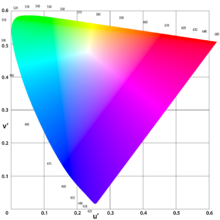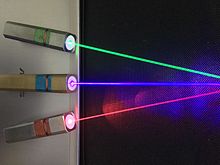What Color Goes With Lime Green Dress
Color evoked by a single wavelength of light in the visible spectrum
| | |||
|---|---|---|---|
| Color | Wavelength (nm) | Frequency (THz) | Photon energy (eV) |
| violet | 380–450 | 670–790 | 2.75–3.26 |
| blue | 450–485 | 620–670 | 2.56–2.75 |
| cyan | 485–500 | 600–620 | 2.48–2.56 |
| green | 500–565 | 530–600 | 2.19–2.48 |
| yellow | 565–590 | 510–530 | 2.10–2.19 |
| orange | 590–625 | 480–510 | 1.98–2.10 |
| red | 625–750 | 400–480 | 1.65–1.98 |

A spectral color is a color that is evoked in a typical human by a single wavelength of light in the visible spectrum, or by a relatively narrow band of wavelengths, also known as monochromatic light. Every wavelength of visible light is perceived as a spectral color, in a continuous spectrum; the colors of sufficiently close wavelengths are indistinguishable for the human eye.
The spectrum is often divided into named colors, though any division is somewhat arbitrary; the spectrum is continuous. Traditional colors in English include: red, orange, yellow, green, cyan (sky-blue), blue ("true" blue), and violet. In some other languages the ranges corresponding to color names do not necessarily agree with those in English.
The division used by Isaac Newton, in his color wheel, was: red, orange, yellow, green, blue, indigo, and violet; a mnemonic for this order is "Roy G. Biv". Less commonly, "VIBGYOR" is also used for the reverse order. In modern divisions of the spectrum, indigo ("true" blue) is often omitted and the modern word cyan is used for sky-blue (which Newton called "blue").
One needs at least trichromatic color vision for there to be a distinction between spectral and non-spectral colours: trichromacy gives a possibility to perceive both hue and saturation in the chroma. In color models capable of representing spectral colors,[note 1] [1] such as CIELUV, a spectral color has the maximal saturation.
In color spaces [edit]

This metrically accurate diagram shows that the spectral locus is almost flat on the red – bright green segment, is strongly curved around the green, and becomes less curved between green/cyan and blue
In color spaces which include all, or most spectral colors, they form a part of boundary of the set of all real colors. If luminance is counted, then spectral colors form a surface, otherwise their locus is a curve in a two-dimensional chromaticity space.
Theoretically, only RGB-implemented colors that might be really spectral are its primaries: red, green, and blue, whereas any other (mixed) color is inherently non-spectral. But due to different chromaticity properties of different spectral segments, and also due to practical limitations of light sources, the actual distance between RGB pure color wheel colors and spectral colors shows a complicated dependence on the hue. Due to the location of R and G primaries near the 'almost flat' spectral segment, RGB color space is reasonably good with approximating spectral orange, yellow, and bright (yellowish) green, but is especially poor in reproducing the visual appearance of spectral colors in the vicinity of central green, and between green and blue, as well as extreme spectral colors approaching IR or UV. The sRGB standard has an additional problem with its "red" primary which is shifted to orange due to a trade-off between the purity of red and its reasonable luminance so that the red spectral became unreachable. Some samples in the table below provide only rough approximations of spectral and near-spectral colors.
CMYK is usually even poorer than RGB in its reach of spectral colors, with the notable exception of process yellow, which is rather close to spectral colors due to the aforementioned flatness of the spectral locus in the red-green segment.
Note that spectral color is universally included in scientific color models such as CIE 1931, but industrial and consumer color spaces such as sRGB, CMYK, and Pantone, do not typically include any spectral colors. Exceptions include Rec. 2020, which uses three spectral colors as primaries (and therefore only includes precisely those three spectral colors), and color spaces such as the ProPhoto RGB color space which use imaginary colors as primaries.
Table of spectral or near-spectral colors [edit]

Red, green, and blue laser beams
Most of the colors listed do not reach the maximal (spectral) colorfulness or are not usually seen with it, but they can be saturated enough to be perceived closely to their dominant wavelength spectral colors. The ranges of wavelengths and frequencies are only approximate.
Wavelengths and frequencies in gray indicate dominant wavelengths and frequencies, not the actual range of spectrum composing a specified color, which extends farther to both sides and is averaged by receptors to give a near-spectral appearance.
| Color term, light source, or dye | Sample [note 2] | Wavelength, nm | Frequency, THz | Hue[note 3] h | Comments | |
|---|---|---|---|---|---|---|
| Red | 740–625[2] | 405–479 | A traditional, broad color term, which includes some nearby non-spectral hues. The short-wave boundary can extend to 620 or even about 610 nanometers | |||
| • Extreme spectral red = red (CIE RGB) | × | 740 | 405 | ? | The exact spectral position has more influence on luminance than on chromaticity in this band; chromaticities are almost the same for these two variants | |
| • red (Wide-gamut RGB primary)[note 4] | × | ≈ 700 | ≈ 428 | ? | ||
| • Helium–neon laser | × | 633 | 473 | ? | ||
| • Some carmine dyes | × | NIR–602[3] | 497-NIR | ? | Near-spectral, but other parts of carmine (color) are purple | |
| • red (sRGB primary) | 614–609 | 488–492 | 0° | Noticeably non-spectral | ||
| Orange | 620–585 625–590[2] | 483–512 479–508 | 0°–30° | The short-wave (yellowish) part corresponds to amber, the long-wave (reddish) side nears (or includes) RGB red above. | ||
| Yellow | 585–560 590–565[2] | 512–540 508–530 | A traditional color term | |||
| • Sodium-vapor lamp | ≈ 589 | ≈ 508 | ? | |||
| • yellow (NCS) | ? | ? | 50° | Gold has almost identical chromaticity at h = 51° | ||
| • Munsell 5Y for V = 10, C = 22[4] | ≈ 577 | ≈ 519 | ? | |||
| • process (canary) yellow | ? | ? | 56° | |||
| • yellow (sRGB secondary) | ≈ 570 | ? | 60° | |||
| • Chartreuse yellow | ? | ? | 68° | |||
| Lime | ≈ 564 | ? | ≈ 75° | May be classified as either green or yellow | ||
| Green | 565–### | 530–### | A traditional, broad color term | |||
| • Chartreuse green | ? | ? | 90° | |||
| • Bright green | ≈ 556 - *$&# | ? | 96° | |||
| • Harlequin | ≈ 552 | ? | 105° | |||
| • green (sRGB primary) | ≈ 549 | ≈ 547 | 120° | Noticeably non-spectral | ||
| • green (Wide-gamut RGB primary)[note 4] | × | ≈ 525 | ≈ 571 | ? | Almost spectral | |
| • Spring green (sRGB definition) | × | ? | ? | 150° | May lie rather far from the spectrum | |
| • green (NCS) | × | ? | ? | 160° | ||
| • Munsell 5G for V = 4, C = 29[4] [note 5] | × | ≈ 503 | ≈ 597 | (?)≈ 163° (extrap.) | ||
| Cyan | 500+–480[5] 520–500[2] | 593–624 576–600 | Sometimes included (or overlaps) with blue, terminological distinction between the two is inconsistent | |||
| • Turquoise | × | ? | ? | ≈ 175° | Most of "turquoise" lies far away of the spectrum | |
| • cyan (sRGB secondary) | × | 488 | ? | 180° | Lie rather far from the spectrum | |
| • process cyan | × | ? | ? | 193° | ||
| Blue | 490–450 500–435[2] | 610–666 600–689 | A traditional, broad color term, which used to include cyan | |||
| • blue (NCS) | × | ? | ? | 197° | Lies rather far from the spectrum | |
| • Azure (sRGB definition) | × | ≈ 488 | ≈ 614 | ≈ 210° | May lie rather far from the spectrum | |
| • Munsell 5B for V = 5, C = 20[4] | × | ≈ 482 | ≈ 622 | (?)≈ 225° (extrap.) | ||
| • blue (RGB primary) | 466–436[note 6] | ? | 240° (of sRGB) | May be classified as indigo or (if indigo is omitted) as violet | ||
| Indigo | ≈ 446 | ≈ 672 | (?)≈ 243° (extrap.) | Definition is controversial, this wavelength least disputably belongs to "indigo" | ||
| Violet | × | 450–400 435–380[2] | 666–750 689–788 | up to 277° (extrap.) | Far spectral violet is very dim and rarely seen. The term also extends to purples | |
[edit]
Among some of the colors that are not, spectral colors are:
- Grayscale (achromatic) colors, such as white, gray, and black.
- Any color obtained by mixing a gray-scale color and another color (either spectral or not), such as pink (a mixture of a reddish color and white), or brown (a mixture of orange and black or gray).
- Violet-red colors, which in color theory include line of purples colors (such as, approximately, magenta and rose), and other variations of purple and red.
- Impossible colors, which cannot be seen under normal viewing of light, such as over-saturated colors or colors that are seemingly brighter than white.
- Metallic colors which reflect light by effect.
Notes [edit]
- ^ The HSL and HSV systems do not qualify, because many spectral colors lie rather far from their gamut.
- ^ VSamples (allegedly in sRGB) currently rely on Wikipedia data which sometimes use poor, unprofessional sources, misinterpretation of sources, or occasionally contain original researches.
- ^ Values for the hue (HSL and HSV or an extrapolation, where necessary) currently rely on Wikipedia data which are prone to miscalculation and other irregularities. Also note that RGB is not an absolute color space, and certain specific standard (such as sRGB) is necessary to map RGB hues to near-spectral colors.
- ^ a b A proprietary color space
- ^ Linearly interpolated between two tabulated values.
- ^ Different definitions of RGB give significantly different wavelengths for blue primary, but this does not change the chromaticity greatly.
References [edit]
- ^ "Perceiving Color" (PDF). courses.washington.edu.
- ^ a b c d e f Thomas J. Bruno, Paris D. N. Svoronos. CRC Handbook of Fundamental Spectroscopic Correlation Charts. CRC Press, 2005. http://hyperphysics.phy-astr.gsu.edu/hbase/vision/specol.html#c1
- ^ Bisulca, Christina (2008). UV-Vis-NIR reflectance spectroscopy of red lakes in paintings (PDF). 9th International Conference on NDT of Art. ndt.net . Retrieved June 19, 2013.
- ^ a b c "Archived copy". Archived from the original on March 3, 2013. Retrieved June 19, 2013. CS1 maint: archived copy as title (link) and commons:File:CIE1931xy blank.svg
- ^ Theeradetch, Detchprohm (2010). "Cyan and green light emitting diode on non-polar m -plane GaN bulk substrate". Physica Status Solidi C. 7: 2190–2192. doi:10.1002/pssc.200983611. [1] [2]
What Color Goes With Lime Green Dress
Source: https://en.wikipedia.org/wiki/Spectral_color

0 Response to "What Color Goes With Lime Green Dress"
Post a Comment